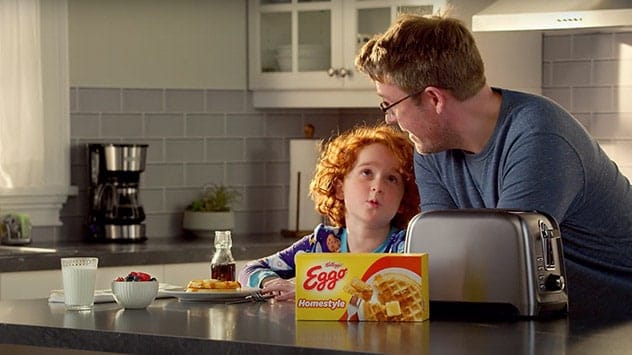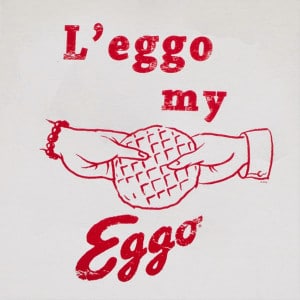
In 1968 the Kellogg Company purchased a frozen waffle company called Eggo.
Four years later they hired the Leo Burnett agency to help them advertised Eggo Waffles to the world.
Hence the birth of one of the greatest advertising slogans — and campaigns — of all time:
“L’eggo my Eggo!”
Here’s the very first commercial that launched the campaign:
How good was this campaign and slogan?
They’re both still in use!
Here are few examples from the various decades in which the campaign has run:
And if there was any doubt, note that Eggo has 73% of the frozen waffle market locked up. Share of market pretty much always follows share of mind.
So what makes this campaign and slogan so brilliant?
The social engineering.
And to understand the brilliance of what Leo Burnett did do, you have to consider what they didn’t do — what a lesser advertising title might have done.
The “First Level” Idea — The Demo Ad / “Food Porn” Approach
 Consider that Eggo Waffles not only are delicious, they look delicious.
Consider that Eggo Waffles not only are delicious, they look delicious.
They can be made incredibly appealing on film.
Plus, they’re dead simple to make. Even a five-year old can do it.
So the straightforward approach would be to show a kid taking ‘em out of the freezer, plopping ‘em into the toaster, and then a close-up on the product dripping in melted butter and syrup, in full “food porn” fashion.
Overlay that with an announcer reading bullet points or some kind of superlative-ridden copy.
“Crispy, fluffy, delicious Eggos are so easy to make, even Suzy can do it. And so delicious you’ll never have to hurry kids to eat their breakfast again.”
That kind of thing.
And while that mediocrity isn’t horrible, it also ain’t anywhere close to the magic of “L’eggo my Eggo.”
So let’s compare that to what Leo Burnett actually did.
Next Level Social Engineering
How do you know when food is really delicious? At least in a family environment?
Kids will fight over it. Even grown kids.
So instead of telling you that Eggos are delicious, the ad shows you family members fighting over the waffles.
The show you the “fight,” letting you conclude the deliciousness on your own.
 Then they crystalize that scenario — of two people fighting for a waffle — with the memorable, metrical phrase: “L’eggo my Eggo”
Then they crystalize that scenario — of two people fighting for a waffle — with the memorable, metrical phrase: “L’eggo my Eggo”
Boom. Freakin’ magic.
They baked the “so good they’ll fight over it” persuasion into the name.
And here’s the kicker: when you view those ads, not only do you assume that the Eggo Waffles are delicious, you assume that it’s a well known fact that they’re delicious.
Like you’re late to the party if you haven’t tried them.
You assume this because the story telling just doesn’t make sense unless the people involved already know how delicious the waffles are.
 If the storytellers can comfortably assume that you, the viewer, know all about Eggo’s appeal, it must be so, right?
If the storytellers can comfortably assume that you, the viewer, know all about Eggo’s appeal, it must be so, right?
That’s why your poor brain, in order to understand the story, swallows the assumption the storyteller’s force fed you.
Think of it as the storytelling version of “forced perspective”
Now, if the storytelling was boring or bland or hard to understand in other ways, no such gap-filling would occur.
But since the ads are fun and interesting, your brain bridges the gap and the persuasion gets baked into you, as well as the name.
It’s why the phrase — and the product — quickly reached pop-culture icon status, showing up in TV shows as diverse as That Seventies Show and Stranger Things.
And that’s the social engineering brilliance of “L’eggo my Eggo.”
- Getting a Foot in the Door — Of Perception - November 27, 2025
- What Digital Superstars Know About Offline Advertising - November 17, 2025
- Unmistakable: A Tale of Two Boots and Branding Done Right - November 8, 2025
